HIST1H2BD
| H2BC5 | |||||||||||||||||||||||||||||||||||||||||||||||||||
|---|---|---|---|---|---|---|---|---|---|---|---|---|---|---|---|---|---|---|---|---|---|---|---|---|---|---|---|---|---|---|---|---|---|---|---|---|---|---|---|---|---|---|---|---|---|---|---|---|---|---|---|
 | |||||||||||||||||||||||||||||||||||||||||||||||||||
| |||||||||||||||||||||||||||||||||||||||||||||||||||
| Identifiers | |||||||||||||||||||||||||||||||||||||||||||||||||||
| Aliases | H2BC5, H2B.1B, H2B/b, H2BFB, HIRIP2, dJ221C16.6, histone cluster 1, H2bd, histone cluster 1 H2B family member d, H2BFG, H2BFL, H2B/k, H2B/l, H2B/h, H2BFK, HIST1H2BE, HIST1H2BC, HIST1H2BG, HIST1H2BI, H2BFA, H2BFH, H2B/a, H2B/g, HIST1H2BF, HIST1H2BD, H2B clustered histone 5 | ||||||||||||||||||||||||||||||||||||||||||||||||||
| External IDs | OMIM: 602799; MGI: 1925553; HomoloGene: 134740; GeneCards: H2BC5; OMA:H2BC5 - orthologs | ||||||||||||||||||||||||||||||||||||||||||||||||||
| |||||||||||||||||||||||||||||||||||||||||||||||||||
| |||||||||||||||||||||||||||||||||||||||||||||||||||
| |||||||||||||||||||||||||||||||||||||||||||||||||||
| |||||||||||||||||||||||||||||||||||||||||||||||||||
| |||||||||||||||||||||||||||||||||||||||||||||||||||
| Wikidata | |||||||||||||||||||||||||||||||||||||||||||||||||||
| |||||||||||||||||||||||||||||||||||||||||||||||||||
Histone H2B type 1-D is a protein that in humans is encoded by the HIST1H2BD gene.[5][6][7]
Histones are basic nuclear proteins that are responsible for the nucleosome structure of the chromosomal fiber in eukaryote. Nucleosomes consist of approximately 146 bp of DNA wrapped around a histone octamer composed of pairs of each of the four core histones (H2A, H2B, H3, and H4). The chromatin fiber is further compacted through the interaction of a linker histone, H1, with the DNA between the nucleosomes to form higher order chromatin structures. This gene is intronless and encodes a member of the histone H2B family. Two transcripts that encode the same protein have been identified for this gene, which is found in the large histone gene cluster on chromosome 6p22-p21.3.[7]
References
- ^ a b c GRCh38: Ensembl release 89: ENSG00000158373 – Ensembl, May 2017
- ^ a b c GRCm38: Ensembl release 89: ENSMUSG00000056895 – Ensembl, May 2017
- ^ "Human PubMed Reference:". National Center for Biotechnology Information, U.S. National Library of Medicine.
- ^ "Mouse PubMed Reference:". National Center for Biotechnology Information, U.S. National Library of Medicine.
- ^ Albig W, Kardalinou E, Drabent B, Zimmer A, Doenecke D (Nov 1991). "Isolation and characterization of two human H1 histone genes within clusters of core histone genes". Genomics. 10 (4): 940–8. doi:10.1016/0888-7543(91)90183-F. PMID 1916825.
- ^ Marzluff WF, Gongidi P, Woods KR, Jin J, Maltais LJ (Oct 2002). "The human and mouse replication-dependent histone genes". Genomics. 80 (5): 487–98. doi:10.1016/S0888-7543(02)96850-3. PMID 12408966.
- ^ a b "Entrez Gene: HIST1H2BD histone cluster 1, H2bd".
Further reading
- Albig W, Kioschis P, Poustka A, et al. (1997). "Human histone gene organization: nonregular arrangement within a large cluster". Genomics. 40 (2): 314–22. doi:10.1006/geno.1996.4592. PMID 9119399.
- Albig W, Doenecke D (1998). "The human histone gene cluster at the D6S105 locus". Hum. Genet. 101 (3): 284–94. doi:10.1007/s004390050630. PMID 9439656. S2CID 38539096.
- El Kharroubi A, Piras G, Zensen R, Martin MA (1998). "Transcriptional Activation of the Integrated Chromatin-Associated Human Immunodeficiency Virus Type 1 Promoter". Mol. Cell. Biol. 18 (5): 2535–44. doi:10.1128/mcb.18.5.2535. PMC 110633. PMID 9566873.
- Lorain S, Quivy JP, Monier-Gavelle F, et al. (1998). "Core Histones and HIRIP3, a Novel Histone-Binding Protein, Directly Interact with WD Repeat Protein HIRA". Mol. Cell. Biol. 18 (9): 5546–56. doi:10.1128/MCB.18.9.5546. PMC 109139. PMID 9710638.
- Deng L, de la Fuente C, Fu P, et al. (2001). "Acetylation of HIV-1 Tat by CBP/P300 increases transcription of integrated HIV-1 genome and enhances binding to core histones". Virology. 277 (2): 278–95. doi:10.1006/viro.2000.0593. PMID 11080476.
- Deng L, Wang D, de la Fuente C, et al. (2001). "Enhancement of the p300 HAT activity by HIV-1 Tat on chromatin DNA". Virology. 289 (2): 312–26. doi:10.1006/viro.2001.1129. PMID 11689053.
- Strausberg RL, Feingold EA, Grouse LH, et al. (2003). "Generation and initial analysis of more than 15,000 full-length human and mouse cDNA sequences". Proc. Natl. Acad. Sci. U.S.A. 99 (26): 16899–903. Bibcode:2002PNAS...9916899M. doi:10.1073/pnas.242603899. PMC 139241. PMID 12477932.
- Cheung WL, Ajiro K, Samejima K, et al. (2003). "Apoptotic phosphorylation of histone H2B is mediated by mammalian sterile twenty kinase". Cell. 113 (4): 507–17. doi:10.1016/S0092-8674(03)00355-6. PMID 12757711. S2CID 21854.
- Mungall AJ, Palmer SA, Sims SK, et al. (2003). "The DNA sequence and analysis of human chromosome 6". Nature. 425 (6960): 805–11. Bibcode:2003Natur.425..805M. doi:10.1038/nature02055. PMID 14574404.
- Lusic M, Marcello A, Cereseto A, Giacca M (2004). "Regulation of HIV-1 gene expression by histone acetylation and factor recruitment at the LTR promoter". EMBO J. 22 (24): 6550–61. doi:10.1093/emboj/cdg631. PMC 291826. PMID 14657027.
- Gerhard DS, Wagner L, Feingold EA, et al. (2004). "The Status, Quality, and Expansion of the NIH Full-Length cDNA Project: The Mammalian Gene Collection (MGC)". Genome Res. 14 (10B): 2121–7. doi:10.1101/gr.2596504. PMC 528928. PMID 15489334.
- Andersen JS, Lam YW, Leung AK, et al. (2005). "Nucleolar proteome dynamics". Nature. 433 (7021): 77–83. Bibcode:2005Natur.433...77A. doi:10.1038/nature03207. PMID 15635413. S2CID 4344740.
- Golebiowski F, Kasprzak KS (2007). "Inhibition of core histones acetylation by carcinogenic nickel(II)". Mol. Cell. Biochem. 279 (1–2): 133–9. doi:10.1007/s11010-005-8285-1. PMID 16283522. S2CID 25071586.
- Zhu B, Zheng Y, Pham AD, et al. (2006). "Monoubiquitination of human histone H2B: the factors involved and their roles in HOX gene regulation". Mol. Cell. 20 (4): 601–11. doi:10.1016/j.molcel.2005.09.025. PMID 16307923.
- Bonenfant D, Coulot M, Towbin H, et al. (2006). "Characterization of histone H2A and H2B variants and their post-translational modifications by mass spectrometry". Mol. Cell. Proteomics. 5 (3): 541–52. doi:10.1074/mcp.M500288-MCP200. PMID 16319397.
- Siuti N, Roth MJ, Mizzen CA, et al. (2006). "Gene-specific characterization of human histone H2B by electron capture dissociation". J. Proteome Res. 5 (2): 233–9. doi:10.1021/pr050268v. PMID 16457587.
- Beck HC, Nielsen EC, Matthiesen R, et al. (2006). "Quantitative proteomic analysis of post-translational modifications of human histones". Mol. Cell. Proteomics. 5 (7): 1314–25. doi:10.1074/mcp.M600007-MCP200. PMID 16627869.
- Pavri R, Zhu B, Li G, et al. (2006). "Histone H2B monoubiquitination functions cooperatively with FACT to regulate elongation by RNA polymerase II". Cell. 125 (4): 703–17. doi:10.1016/j.cell.2006.04.029. PMID 16713563. S2CID 2614680.
- v
- t
- e
-
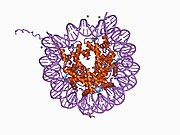 1aoi: COMPLEX BETWEEN NUCLEOSOME CORE PARTICLE (H3,H4,H2A,H2B) AND 146 BP LONG DNA FRAGMENT
1aoi: COMPLEX BETWEEN NUCLEOSOME CORE PARTICLE (H3,H4,H2A,H2B) AND 146 BP LONG DNA FRAGMENT -
 1eqz: X-RAY STRUCTURE OF THE NUCLEOSOME CORE PARTICLE AT 2.5 A RESOLUTION
1eqz: X-RAY STRUCTURE OF THE NUCLEOSOME CORE PARTICLE AT 2.5 A RESOLUTION -
 1f66: 2.6 A CRYSTAL STRUCTURE OF A NUCLEOSOME CORE PARTICLE CONTAINING THE VARIANT HISTONE H2A.Z
1f66: 2.6 A CRYSTAL STRUCTURE OF A NUCLEOSOME CORE PARTICLE CONTAINING THE VARIANT HISTONE H2A.Z -
 1hq3: CRYSTAL STRUCTURE OF THE HISTONE-CORE-OCTAMER IN KCL/PHOSPHATE
1hq3: CRYSTAL STRUCTURE OF THE HISTONE-CORE-OCTAMER IN KCL/PHOSPHATE -
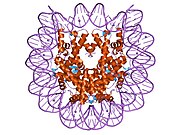 1kx3: X-Ray Structure of the Nucleosome Core Particle, NCP146, at 2.0 A Resolution
1kx3: X-Ray Structure of the Nucleosome Core Particle, NCP146, at 2.0 A Resolution -
 1kx4: X-Ray Structure of the Nucleosome Core Particle, NCP146b, at 2.6 A Resolution
1kx4: X-Ray Structure of the Nucleosome Core Particle, NCP146b, at 2.6 A Resolution -
 1kx5: X-Ray Structure of the Nucleosome Core Particle, NCP147, at 1.9 A Resolution
1kx5: X-Ray Structure of the Nucleosome Core Particle, NCP147, at 1.9 A Resolution -
 1m18: LIGAND BINDING ALTERS THE STRUCTURE AND DYNAMICS OF NUCLEOSOMAL DNA
1m18: LIGAND BINDING ALTERS THE STRUCTURE AND DYNAMICS OF NUCLEOSOMAL DNA -
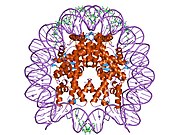 1m19: LIGAND BINDING ALTERS THE STRUCTURE AND DYNAMICS OF NUCLEOSOMAL DNA
1m19: LIGAND BINDING ALTERS THE STRUCTURE AND DYNAMICS OF NUCLEOSOMAL DNA -
 1m1a: LIGAND BINDING ALTERS THE STRUCTURE AND DYNAMICS OF NUCLEOSOMAL DNA
1m1a: LIGAND BINDING ALTERS THE STRUCTURE AND DYNAMICS OF NUCLEOSOMAL DNA -
 1p34: Crystallographic Studies of Nucleosome Core Particles containing Histone 'Sin' Mutants
1p34: Crystallographic Studies of Nucleosome Core Particles containing Histone 'Sin' Mutants -
 1p3a: Crystallographic Studies of Nucleosome Core Particles containing Histone 'Sin' Mutants
1p3a: Crystallographic Studies of Nucleosome Core Particles containing Histone 'Sin' Mutants -
 1p3b: Crystallographic Studies of Nucleosome Core Particles containing Histone 'Sin' Mutants
1p3b: Crystallographic Studies of Nucleosome Core Particles containing Histone 'Sin' Mutants -
 1p3f: Crystallographic Studies of Nucleosome Core Particles containing Histone 'Sin' Mutants
1p3f: Crystallographic Studies of Nucleosome Core Particles containing Histone 'Sin' Mutants -
 1p3g: Crystallographic Studies of Nucleosome Core Particles containing Histone 'Sin' Mutants
1p3g: Crystallographic Studies of Nucleosome Core Particles containing Histone 'Sin' Mutants -
 1p3i: Crystallographic Studies of Nucleosome Core Particles containing Histone 'Sin' Mutants
1p3i: Crystallographic Studies of Nucleosome Core Particles containing Histone 'Sin' Mutants -
 1p3k: Crystallographic Studies of Nucleosome Core Particles containing Histone 'Sin' Mutants
1p3k: Crystallographic Studies of Nucleosome Core Particles containing Histone 'Sin' Mutants -
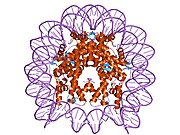 1p3l: Crystallographic Studies of Nucleosome Core Particles containing Histone 'Sin' Mutants
1p3l: Crystallographic Studies of Nucleosome Core Particles containing Histone 'Sin' Mutants -
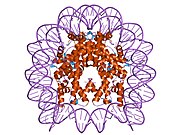 1p3m: Crystallographic Studies of Nucleosome Core Particles containing Histone 'Sin' Mutants
1p3m: Crystallographic Studies of Nucleosome Core Particles containing Histone 'Sin' Mutants -
 1p3o: Crystallographic Studies of Nucleosome Core Particles containing Histone 'Sin' Mutants
1p3o: Crystallographic Studies of Nucleosome Core Particles containing Histone 'Sin' Mutants -
 1p3p: Crystallographic Studies of Nucleosome Core Particles containing Histone 'Sin' Mutants
1p3p: Crystallographic Studies of Nucleosome Core Particles containing Histone 'Sin' Mutants -
 1s32: Molecular Recognition of the Nucleosomal 'Supergroove'
1s32: Molecular Recognition of the Nucleosomal 'Supergroove' -
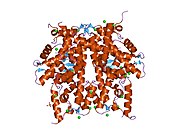 1tzy: Crystal Structure of the Core-Histone Octamer to 1.90 Angstrom Resolution
1tzy: Crystal Structure of the Core-Histone Octamer to 1.90 Angstrom Resolution -
 1u35: Crystal structure of the nucleosome core particle containing the histone domain of macroH2A
1u35: Crystal structure of the nucleosome core particle containing the histone domain of macroH2A -
 1zbb: Structure of the 4_601_167 Tetranucleosome
1zbb: Structure of the 4_601_167 Tetranucleosome -
 1zla: X-ray Structure of a Kaposi's sarcoma herpesvirus LANA peptide bound to the nucleosomal core
1zla: X-ray Structure of a Kaposi's sarcoma herpesvirus LANA peptide bound to the nucleosomal core -
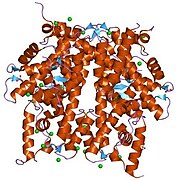 2aro: Crystal Structure Of The Native Histone Octamer To 2.1 Angstrom Resolution, Crystalised In The Presence Of S-Nitrosoglutathione
2aro: Crystal Structure Of The Native Histone Octamer To 2.1 Angstrom Resolution, Crystalised In The Presence Of S-Nitrosoglutathione -
 2cv5: Crystal structure of human nucleosome core particle
2cv5: Crystal structure of human nucleosome core particle -
 2f8n: 2.9 Angstrom X-ray structure of hybrid macroH2A nucleosomes
2f8n: 2.9 Angstrom X-ray structure of hybrid macroH2A nucleosomes -
 2fj7: Crystal structure of Nucleosome Core Particle Containing a Poly (dA.dT) Sequence Element
2fj7: Crystal structure of Nucleosome Core Particle Containing a Poly (dA.dT) Sequence Element -
 2hio: HISTONE OCTAMER (CHICKEN), CHROMOSOMAL PROTEIN
2hio: HISTONE OCTAMER (CHICKEN), CHROMOSOMAL PROTEIN -
 2nzd: Nucleosome core particle containing 145 bp of DNA
2nzd: Nucleosome core particle containing 145 bp of DNA
 | This article on a gene on human chromosome 6 is a stub. You can help Wikipedia by expanding it. |
- v
- t
- e
















































